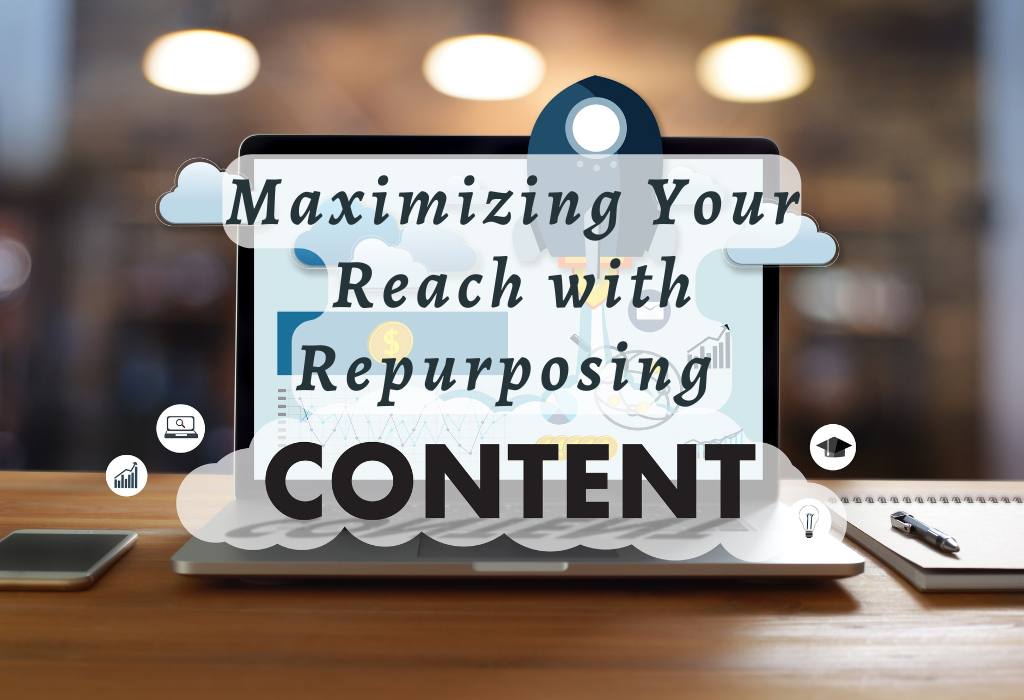Maximizing Your Reach with Repurposing Content
Content marketing is an important part of any successful SEO strategy. Repurposing content, the process of adapting existing pieces to create new and exciting materials, can be a powerful tool in your arsenal when it comes to driving traffic and boosting visibility. From blog posts and e-books to podcasts and infographics, there are many ways you can repurpose content for maximum impact on your audience – but only if done correctly.
In this article, we will discuss what repurposing content is, its benefits, the types of repurposed material available, as well as how best to go about creating effective reworked materials that engage with readers.
We’ll also cover tools for helping you get started with content creation, as well as tips on measuring success so that you know exactly what kind of results are being achieved from your efforts. Join us now! While we explore the world of repurposing content.

What is Repurposing Content?
Repurposing content is the process of taking existing content and reusing it in different formats. It’s a great way for marketers to maximize their efforts and get more out of their original content. Repurposing can help extend the reach of your message, increase engagement with your audience, and save time by not having to create new material from scratch.
It’s a great way to maximize your reach and create multiple versions of the same message for different audiences. By doing so, you can get more mileage out of each piece of content, helping you reach more people and increase engagement. Let’s take a look at the benefits of repurposing content.
Key Takeaway: Repurposing content is a great way to extend the reach of your message, increase engagement with your audience and save time. It helps marketers maximize their efforts.
Benefits of Repurposing Content
By repurposing content, you can reach new audiences and improve your SEO rankings without creating entirely new pieces of content from scratch. Here are some of the key benefits of repurposing content.
Increased Reach
Repurposing your existing content into different formats allows you to reach a wider audience than if you only published it in one format. For example, if you have an article on your blog about a topic, consider turning it into an infographic or video that can be shared across multiple social media platforms. This will help increase the visibility and reach of your message.
Improved SEO Rankings
Search engine algorithms take into account how often people share and link back to your website when ranking websites in search results. By creating multiple versions of the same piece of content (such as an article, infographic, podcast episode, etc.), you’ll be able to generate more links back to your website, which will help boost its overall SEO rankings over time.
More Efficient Use Of Resources
Creating original pieces of content takes time and resources – both financial and human capital – so why not use what already exists? Repurposing existing pieces makes efficient use of these resources by allowing them to be used again in different forms with minimal effort required on behalf of the creator(s).
Time-Saving Benefits
Creating original pieces requires a significant amount of research and planning before any actual writing begins. However, when repurposing existing material, much less preparation is needed since all the information has already been gathered previously. This saves a considerable amount of time that would otherwise have been spent researching topics from scratch each time something needs publishing or updating online.
Requires Fewer Investments
Repurposing materials require far fewer investments than creating original ones, both in terms of money (for hiring writers/designers) and human capital (time spent researching/writing).
This translates directly into cost savings for businesses who choose this route instead of opting for completely fresh material every single time they want to publish something online.
Repurposing content is a great way to maximize the reach of your content and increase engagement with your audience, so let’s look at some types of repurposed content you can use.
Key Takeaway: Repurposing content offers several benefits, including increased reach, improved SEO rankings, more efficient use of resources, and time-saving advantages.
Types of Repurposed Content
It involves transforming existing content into a different format or medium, such as video, podcast, infographic, etc. This allows you to reach new audiences and maximize your content’s potential without having to start from scratch every time. Here are some very popular types of repurposed content.
Blog Posts
Blog posts are one of the most common types of repurposed content. You can take an old blog post that has already been successful and turn it into something else, like a video or podcast episode. This allows you to reach more people who may not have seen your original post but would be interested in hearing about it in another form.
Videos
Videos are also great for repurposing content because they can easily be shared across multiple platforms like YouTube and social media sites like Facebook and Twitter. You can take an old blog post or article and create a short video summarizing its main points or explaining how readers can apply what they learned from reading it.
Podcasts
Podcasts are becoming increasingly popular among marketers looking to repurpose their existing material into something new and exciting for listeners. By creating audio versions of blog posts or articles, you can engage with listeners on topics that might otherwise go unnoticed by other mediums, such as print publications or websites alone.
Infographics
These provide a visual representation of data that helps readers quickly understand complex concepts in easy-to-digest chunks of information. It’s perfect for those who don’t have much time on their hands but still want access to valuable insights.
Take an old blog post full of facts and figures related to your industry, then transform them into eye-catching infographics that will grab attention online while providing useful information at the same time.
From blog posts to infographics, many different types of content can be repurposed. Now let’s look at how you can actually repurpose your content.
Key Takeaway: Repurposing content is an effective way to reach new audiences and maximize the potential of existing material. Examples include blog posts, videos, podcasts, and infographics.
How to Repurpose Content
Now when you’ve already read about the benefits of repurposing content and different types of it. Here are some tips on how to repurpose content for maximum impact.
- Identify Your Content
Before you start repurposing any content, it’s important to identify what type of available content that could be reused or adapted. This includes articles, videos, podcasts, infographics, presentations, and more.
- Choose a Format
Once you’ve identified the type of content you want to repurpose, decide which format would work best for each piece of material. For example, if you have an article about marketing trends in 2023, consider turning this into a podcast episode or infographic instead of just another blog post on the same topic.
- Break Down Content Into Chunks
Breaking down large pieces of content into smaller chunks makes them easier to digest and share across multiple platforms at once – such as social media channels or email newsletters – without overwhelming readers with too much information at once.
- Update Content Regularly
Repurposed materials should always be kept up-to-date. So, they remain relevant and useful for audiences over time, especially when discussing topics related to current events or industry news that may change quickly from day to day.
- Promote Your Content
After creating new versions of your original material, don’t forget to promote them. Utilize all available channels, including social media networks, email campaigns, SEO tactics, influencer outreach strategies, etc., to ensure maximum visibility for each piece.
- Track Metrics for Success Evaluation
Track metrics such as page views, shares, and comments across all platforms where your repurposed materials were published. This will help gauge success levels so that adjustments can be made accordingly.
By repurposing content, you can maximize the reach of your message and make it easier to promote. With the right tools, you can take advantage of this strategy even more efficiently.
Key Takeaway: Repurposing content is an effective way to maximize reach and engagement. Tips include: identify content, choose a format, break down into chunks, updating regularly, and promoting across channels—tracking metrics for success evaluation.
10 Genius Ways to Repurpose Content
- Create a Video
Take your existing content and create an engaging video that will draw in new viewers. You can use tools like Animoto or Powtoon to make the process easier.
- Write a Book
If you have enough content, consider writing an ebook about it. This is a great way to reach out to readers who may not be familiar with your work yet and give them something valuable for free.
- Turn It Into An Infographic
Visuals are powerful in marketing, so why not turn some of your best content into infographics? Use Piktochart or Canva to get started quickly and easily.
- Start A Podcast Series
Repurpose some of your blog posts into podcast episodes by adding audio interviews with experts in the field, narrating stories from customers, etc.
- Make A Slideshow Presentation
Have you ever thought about turning some of your articles into slideshows? This is another great way to repurpose content while also making it more visually appealing for viewers.
- Transform Your Content Into Webinars And Online Courses
Are there topics within your niche that could benefit from further exploration? Consider creating webinars or online courses around these topics and other related ones using existing material you already have.
- Create Social Media Posts From Existing Content
Got any old blog posts lying around? Why not take snippets from those posts and turn them into social media updates? Doing this allows you to share information quickly without having to write anything new – bonus points if you add visuals too.
- Repurpose Your Articles As Email Newsletters
If you’re looking for ways to engage with subscribers, why not email newsletters containing excerpts from previous articles? Doing this gives readers something fresh but still relevant every time they open their inboxes.
- Make Quizzes Out Of Old Content
Quizzes are fun and interactive and can help drive engagement on social media platforms. Consider taking pieces of older articles and turning them into quizzes – remember, keep things lighthearted.
- Turn Articles Into Videos For YouTube:
YouTube has become one of the most popular platforms today – so why not leverage its power by transforming old blog posts into videos? Just make sure they’re interesting enough for people to watch all the way through.
Key Takeaway: As a marketer, you can repurpose content in 10 different ways, from making podcasts and infographics to creating social media posts and turning your articles into YouTube videos.
Tools for Repurposing Content
When it comes to repurposing content, there are a variety of tools available that can help make the process easier. From design software and video editing tools to audio recording apps and more, marketers have plenty of options when it comes to repurposing their content.
Design Software
Design software such as Adobe Photoshop or Canva is essential for creating visuals for your blog posts, social media updates, and other digital marketing materials. With these programs, you can create stunning graphics quickly and easily without hiring a professional designer.
Video Editing Tools
Video editing tools like iMovie or Final Cut Pro allow you to edit videos with ease. You can add text overlays, transitions, music tracks, voiceovers, and more to create engaging videos that will grab your audience’s attention.
Audio Recording Apps
Audio recording apps such as Audacity are great for creating podcasts or audio recordings from interviews or webinars that you’ve held on your website or blog. These recordings can then be used in other formats, such as ebooks or slideshows, to promote your brand further online.
Slideshow Presentation Tools
Slideshow presentation tools like Prezi offer an alternative way of presenting information visually rather than using traditional PowerPoint presentations, which may become boring after a while if overused too often by marketers who rely heavily on them for their campaigns.
Social Media Management Platforms
Social media management platforms like Hootsuite allow users to manage multiple accounts across different networks all at once, thus saving time and energy in the long run. This eliminates the need for manually posting each update separately on each platform whenever something needs to be shared with their followers online.
By utilizing the right tools, you can easily repurpose content to maximize its reach and increase engagement. Now let’s look at best practices for getting the most out of your content repurposing efforts.
Key Takeaway: Marketers have various tools available to help them repurpose content, including design software, video editing tools, audio recording apps, slideshow presentation tools, and social media management platforms.
Measuring Success with Repurposed Content
When it comes to content marketing, repurposing content is a great way to maximize the reach of your message and ensure that your audience sees it. But how do you know if your efforts are paying off? To measure success using repurposed content, look at metrics such as engagement rate and website traffic.
Engagement Rate
The engagement rate measures how much interaction people have with your post or page on social media platforms like Facebook, Twitter, Instagram, etc. This metric can help you determine whether people are actually engaging with the content you’re sharing or not.
A high engagement rate indicates that people are interested in what you’re saying and are more likely to take action based on it. Conversely, a low engagement rate may indicate that something needs to be changed about the type of content being shared or its delivery method (e.g., timing).
Website Traffic
Another key metric for measuring success when using repurposed content is website traffic. If people are engaging with your posts but not clicking through to visit your site, then there could be an issue with either the quality of the links provided in those posts or their placement within them (e.g., too far down).
Analyzing website traffic data will give insight into which repurposed content was most successful at driving visitors back to your site. So that they can explore further options available from there (e.g., signing up for a newsletter).
Time Spent on Page/Site
Finally, another important metric for measuring success when using repurposed content is time spent on the page/site. This tells you how long someone stayed after visiting one of your pages or sites via a link from one of your posts before leaving again without taking any other action (such as subscribing).
If this number is low compared to other similar pages/sites, then it could mean that something isn’t quite right about either the post itself or where it was posted. Conversely, if this number is higher than average, then it means people found value in what they saw and stayed longer than usual because of it.
Key Takeaway: To measure success using repurposed content, analyze metrics such as engagement rate, website traffic, and time spent on the page/ site.
FAQs About Repurposing Content
Conclusion
Repurposing can help create more engaging content, increase website traffic, and boost SEO rankings. By understanding the different types of repurposed content available, utilizing the right tools, following best practices, and measuring success accurately, marketers can make sure that they are getting the most out of their repurposing content efforts.
Are you struggling to find effective ways to repurpose content and increase your SEO rankings?
Look no further than curationsoft! Our comprehensive suite of tools allows users to quickly and easily create high-quality, optimized content that will boost online visibility. With our powerful platform, you can rest assured knowing the right people will see your website at the right time – so don’t wait any longer.






